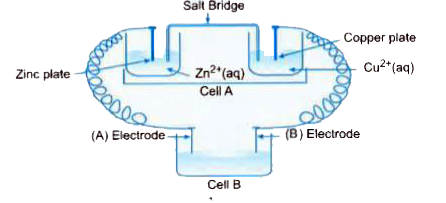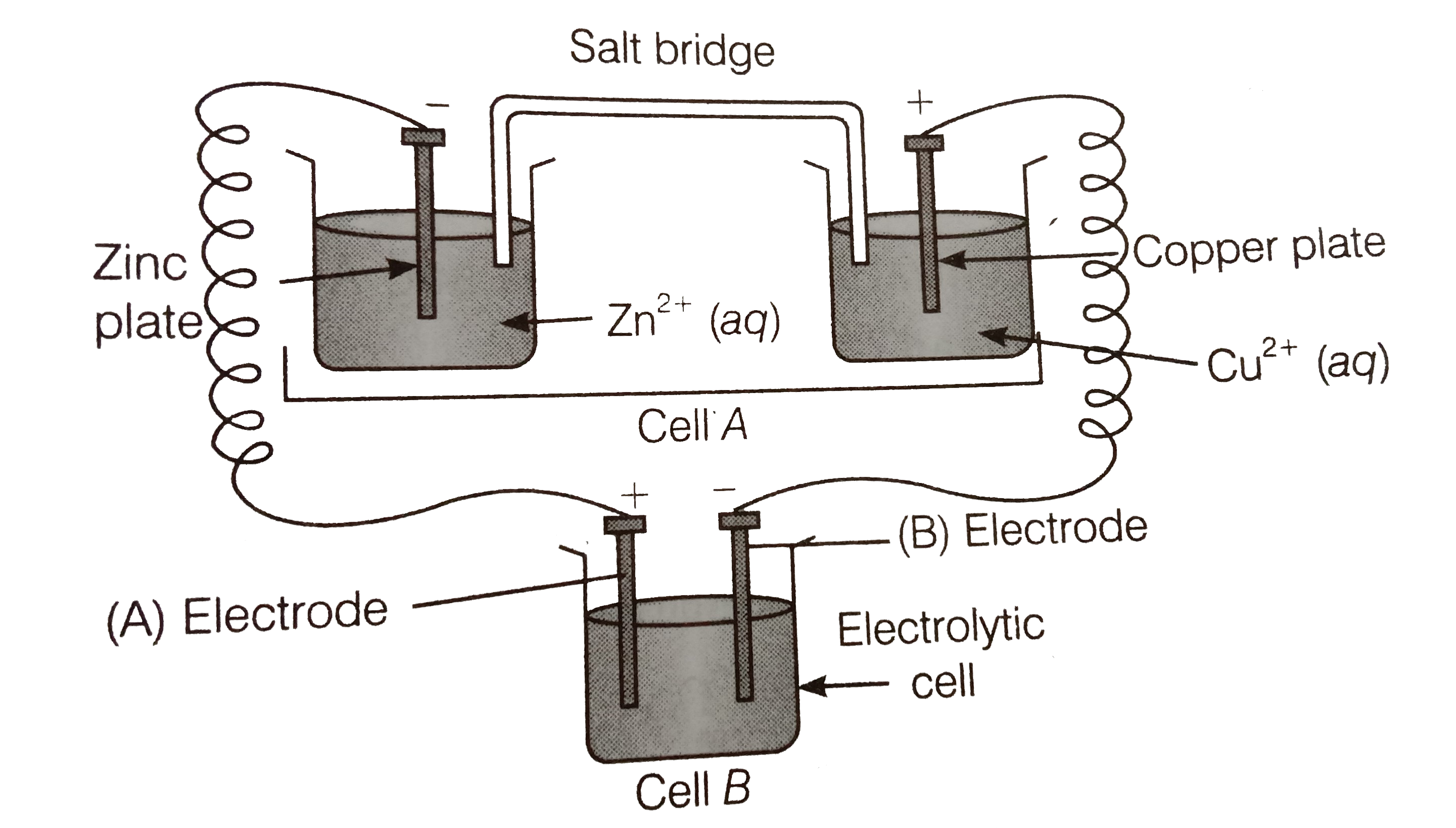E∘ of a cell aA+bB→cC+dD is
−RTnFlog[C]C[D]d[A]a[B]b
−Rtlog[a]A[b]B[a]C[d]D
−RTnFlog[C]c[d]D[A]a[B]b
−RTnFlog[C]c[d]D[a]A[B]b
The correct Answer is:A
To determine the standard electrode potential E∘ of a cell for the reaction aA+bB→cC+dD, we use the Nernst equation. The Nernst equation allows us to calculate the cell potential under non-standard conditions. The standard form of the Nernst equation is:
E=E∘−RTnFlnQ
where:
- E is the cell potential under non-standard conditions,
- E∘ is the standard cell potential,
- R is the universal gas constant (8.314J/mol⋅K),
- T is the temperature in Kelvin,
- n is the number of moles of electrons transferred in the reaction,
- F is the Faraday constant (96485C/mol),
- Q is the reaction quotient.
For the reaction aA+bB→cC+dD, the reaction quotient Q is given by:
Q=(C)c(D)d(A)a(B)b
Now, substituting Q into the Nernst equation, we get:
E=E∘−RTnFln((C)c(D)d(A)a(B)b)
However, the question specifically asks for the standard electrode potential E∘ of the cell. The standard electrode potential E∘ is a constant value that is determined under standard conditions (1 M concentration for solutions, 1 atm pressure for gases, and 298 K temperature).
Therefore, the standard electrode potential E∘ for the cell reaction aA+bB→cC+dD is simply E∘.
1. Identify the cell reaction:
The given cell reaction is aA+bB→cC+dD.
2. Write the Nernst equation:
The Nernst equation is:
E=E∘−RTnFlnQ
3. Determine the reaction quotient Q:
For the reaction aA+bB→cC+dD, the reaction quotient Q is:
Q=(C)c(D)d(A)a(B)b
4. Substitute Q into the Nernst equation:
E=E∘−RTnFln((C)c(D)d(A)a(B)b)
5. Identify the standard electrode potential E∘:
The standard electrode potential E∘ is the value of the cell potential under standard conditions.
Therefore, the standard electrode potential E∘ for the cell reaction aA+bB→cC+dD is E∘.
- E is the cell potential under non-standard conditions,
- E∘ is the standard cell potential,
- R is the universal gas constant (8.314J/mol⋅K),
- T is the temperature in Kelvin,
- n is the number of moles of electrons transferred in the reaction,
- F is the Faraday constant (96485C/mol),
- Q is the reaction quotient.
The given cell reaction is aA+bB→cC+dD.
The Nernst equation is:
E=E∘−RTnFlnQ
For the reaction aA+bB→cC+dD, the reaction quotient Q is:
Q=(C)c(D)d(A)a(B)b
E=E∘−RTnFln((C)c(D)d(A)a(B)b)
The standard electrode potential E∘ is the value of the cell potential under standard conditions.
Similar Questions
Equilibrium constant with respect to concentrations of reactants and products (Kc) for reaction aA+bB ↔ cC+dD where [A],[B],[C],[D] are concentrations of reactants and products
View SolutionConsider the figure below and answer the following questions :

(i) Cell 'A' has Ecell=2V and Cell 'B' has Ecell=1.1V which of the two cells 'A' or 'B' will act as an electrolytic cell. Which electrode reaction will occur in this cell?
(ii) If cell 'A' has Ecell=0.5V and cell 'B' has Ecell=1.1V then what will be the reaction at anode and cathode?
View Solution
Knowledge Check
If the following half cells have E∘ values as
A3++e−→A2−,E∘=y2V
A2++2e−→A,E∘=−y1V
The E∘ of the half cell A3++3e→A will beA2y1−y23By2−2y13C2y1−3y2Dy2−2y1The terminal potential difference of a cell when short-circuited is (E = E.M.F. of the cell)
AEBE/2CZeroDE/3The e.m.f. of a cell is a
Aunit vectorBzero vectorCscalar quantityDvector quantity
Consider the figure and answer the following question.

(i) Cell 'A' h as Ecell=2V and Cell 'B' has Ecell=1.1V which of the two cell 'A' or 'B' will act as an electrolytic cell. Which electrode reactions will occur in this cell?
(ii) If cell 'A' has Ecell= 0.5V and cell 'B' has Ecell=1.1V then what will be the reactions at anode and cathode?
View SolutionConsider the figure below and answer the following questions :
(i) Cell 'A' has Ecell=2 V and Cell B has Ecell=1.1 V which of the two cells 'A' or 'B' will act as an electrolytic cell. Which electrode reactions will occur in this cell ?
(ii) If cell 'A' has Ecell=0.5 V and cell 'B' has Ecell=1.1 V then what will be the reactions at anode and cathode ?

View Solution(a) In a cell reaction, equilibrium constant L is less than one. Is E∘ for the cell positive or negative ?
(b) What will be the value of K if E∘cell=0 ?
View SolutionIn a gaseous reaction of the type
aA+bB→cC+dD, which is wrong:
View SolutionIn the following electrochemical cell
Zn∣∣Zn2+∣∣∣∣H+∣∣pt(H2)
E∘_(cell)=Ecell. This will be :
View Solution
